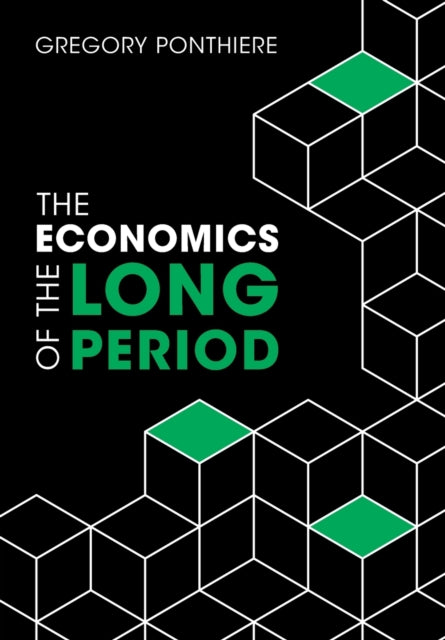GregoryPonthiere
The Economics of the Long Period
The Economics of the Long Period
YOU SAVE £1.34
- Condition: Brand new
- UK Delivery times: Usually arrives within 2 - 3 working days
- UK Shipping: Fee starts at £2.39. Subject to product weight & dimension
Bulk ordering. Want 15 or more copies? Get a personalised quote and bigger discounts. Learn more about bulk orders.
Couldn't load pickup availability
- More about The Economics of the Long Period
This book provides a non-technical introduction to Unified Growth Theory (UGT), which studies history as a succession of economic regimes, focusing on the transition from Malthusian stagnation to sustained economic growth and examining other regime shifts involving institutional and environmental forces. It fills a gap in the market by offering a more accessible treatment of UGT and encourages readers to explore ideas of continuity and discontinuity in history.
Format: Paperback / softback
Length: 300 pages
Publication date: 25 August 2022
Publisher: Cambridge University Press
This comprehensive book offers a non-technical introduction to Unified Growth Theory (UGT), a fascinating field that delves into the study of history as a series of economic regimes. It begins by exploring the canonical example of a regime shift, namely the transition from the era of Malthusian stagnation to the modern regime of sustained economic growth. However, the book goes beyond this narrow focus by examining other significant regime shifts driven by institutional and environmental forces. By providing a more accessible treatment of UGT, this book aims to bridge the gap in the market and encourage readers to engage with the concept of continuity and discontinuity in history.
The book begins by providing a historical backdrop, outlining the key events and developments that shaped the transition from stagnation to growth. It then delves into the theoretical framework of UGT, explaining the key concepts and principles that govern economic regimes. The authors use real-world examples and case studies to illustrate how UGT can be applied to understand the past and predict future economic trends.
One of the key strengths of the book is its ability to explain complex economic concepts in a straightforward and accessible manner. The authors use clear and concise language, avoiding technical jargon and making the book suitable for a wide range of readers, including students, researchers, and policymakers. Additionally, the book includes numerous visual aids, such as charts and diagrams, to help illustrate the key points and make the material more engaging.
Throughout the book, the authors emphasize the importance of understanding the historical context in which economic regimes operate. They argue that economic systems are not static entities but are constantly evolving and adapting to changing circumstances. By examining the patterns of change and continuity in history, readers can gain a deeper understanding of the forces that shape economic development and the potential for long-term growth.
Another important aspect of the book is its exploration of the role of institutions and environmental factors in shaping economic regimes. The authors argue that institutions, such as government policies, legal frameworks, and social norms, play a critical role in determining the success or failure of economic systems. Similarly, environmental factors, such as natural resources, climate change, and technological advancements, can have a significant impact on economic growth and development.
The book also addresses the challenges and limitations of UGT as a theoretical framework. While it provides a valuable tool for understanding historical change, it does not account for all the complexities and nuances of economic systems. The authors acknowledge that there are still many unanswered questions and areas of research that need to be addressed in the future.
In conclusion, this book is a valuable resource for anyone interested in the study of history, economics, and economic development. It provides a comprehensive and accessible introduction to Unified Growth Theory and encourages readers to explore the ideas of continuity and discontinuity in history. By providing a clear and concise explanation of complex economic concepts, the book makes it accessible to a wide range of readers and helps to bridge the gap between theory and practice. Whether you are a student, researcher, or policymaker, this book will provide you with valuable insights and tools for understanding the past and predicting the future.
Weight: 409g
ISBN-13: 9781009169745
This item can be found in:
UK and International shipping information
UK and International shipping information
UK Delivery and returns information:
- Delivery within 2 - 3 days when ordering in the UK.
- Shipping fee for UK customers from £2.39. Fully tracked shipping service available.
- Returns policy: Return within 30 days of receipt for full refund.
International deliveries:
Shulph Ink now ships to Australia, Belgium, Canada, France, Germany, Ireland, Italy, India, Luxembourg Saudi Arabia, Singapore, Spain, Netherlands, New Zealand, United Arab Emirates, United States of America.
- Delivery times: within 5 - 10 days for international orders.
- Shipping fee: charges vary for overseas orders. Only tracked services are available for most international orders. Some countries have untracked shipping options.
- Customs charges: If ordering to addresses outside the United Kingdom, you may or may not incur additional customs and duties fees during local delivery.


